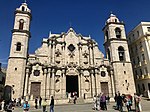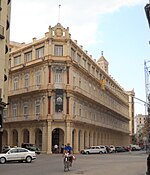Church Santo Cristo del Buen Viaje, Havana
15th-century Roman Catholic church buildingsArchitecture in HavanaBuildings and structures in HavanaChurches in HavanaHistory of Havana ... and 4 more
Neoclassical church buildings in CubaReligious buildings and structures in HavanaRoman Catholic churches in HavanaTourist attractions in Havana

The Iglesia del Santo Cristo del Buen Viaje is located in Havana Vieja on Calle Cristo between Calles Lamparilla y Teniente Rey. Built at a time in which transatlantic crossings were risky, it acquired popularity during colonial times as a temple dedicated to travelers and navigators. Travelers and especially sailors would visit before leaving on a journey, and to pay their respects upon arriving back on land. Later during Cuba's republican era, the devotion to Santa Rita was added to the church.
Excerpt from the Wikipedia article Church Santo Cristo del Buen Viaje, Havana (License: CC BY-SA 3.0, Authors, Images).Church Santo Cristo del Buen Viaje, Havana
Villegas, Havana
Geographical coordinates (GPS) Address Nearby Places Show on map
Geographical coordinates (GPS)
| Latitude | Longitude |
|---|---|
| N 23.13616 ° | E -82.35605 ° |
Address
Orden de San Agustín (frailes agustinos en La Habana)
Villegas
10102 Havana (Plaza Vieja, La Habana Vieja)
Havana, Cuba
Open on Google Maps










